Tooth decay and cavities affect the majority of people at some point in their lives. More than four in five adults in the UK have at least one filling, and the average adult has seven. It’s estimated that around one-third of British adults are suffering from dental decay right now – worldwide that number is a great deal higher.
So if you’re worried about the state of your teeth, you’re certainly not alone. Fortunately, if caught early, it’s easy to treat decay and prevent an oral cavity from developing. If left untreated, decay can lead to more serious dental problems like abscesses and tooth loss.
In this guide, we explain what tooth decay is, what causes it, and how it can be prevented and treated. You can also discover how it leads to cavities, and ways to stop the infection from developing this far.
The condition is worryingly common in children too. So, we’ve included some information on how to recognise the signs, what to do if your child has a cavity, and how to prevent further damage to their teeth.
What is tooth decay?
Bacteria in your mouth collect in a sticky film on your teeth known as plaque, and they feed off sugary foods and drinks and produce acid. This acid will start to eat away at the surface of your tooth.
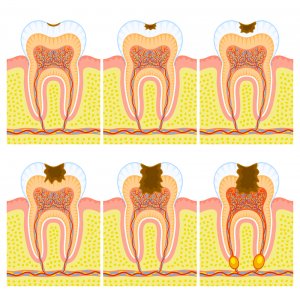
The outer layer of your tooth, called enamel, is a strong substance which your body can replenish over time. But once the build-up of bacteria reaches a certain point, your body can’t keep up and your tooth enamel starts to decay. The medical term for decaying teeth is dental caries.
Two-thirds of Brits have visible plaque on their teeth. Plaque most often gathers around the gum line, along the edges of existing fillings, where teeth connect, and in the ridges on the biting surfaces of teeth.
Plaque can be removed from teeth by brushing and flossing, but if left for long enough it hardens into a substance called tartar. This is a breeding ground for those acid-producing bacteria, but tartar can only be removed with proper dental cleaning. If not removed, it can lead to gum disease.
Read more about plaque and tartar.
What is a cavity?
Once there is a hole in the enamel of your tooth, the bacteria can spread to the inner layers of dentin and pulp. These have no way of fighting decay, so the infection can spread rapidly. The resulting hole in the tooth is called a cavity.
Simply put, we can define a cavity as a hole that forms inside a tooth when decay is left to spread. It only takes a tiny hole in the enamel for a large cavity to form inside the tooth.
If the cavity spreads to the dental pulp inside the decayed tooth it starts to kill off the nerves and blood vessels. In the end, the tissue in the tooth dies and becomes discoloured.
The bacteria can also form a tooth or gum abscess at the root of the tooth or in the surrounding gum tissue. The infection may eventually spread into other parts of the body through the bloodstream, causing serious health problems.
What causes tooth decay?
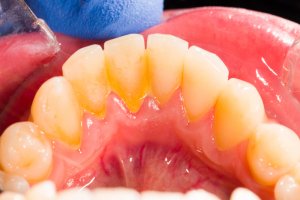
We are all susceptible to dental caries if we don’t take care of our teeth. Causes of decay in teeth include consuming food and drink that is high in carbohydrates. Other culprits include
- Eating a lot of citrus fruits, which are very acidic
- Drinking acidic beverages such as fizzy drinks and sports drinks
- Drinking alcohol daily (especially beer)
- Snacking in between meals
- Poor oral hygiene
- Smoking
- Failing to have regular dental checkups
- Not cleaning teeth properly while wearing braces
- Lack of saliva in the mouth, known as dry mouth or xerostomia
- A relatively rare condition called tooth resorption
The good news is that these factors are all things that you can work to improve. By controlling what you eat and drink, cleaning your teeth well, and visiting the dentist regularly you can reduce the chances of your teeth decaying and developing cavities.
Remember, our teeth decay because of the bacteria contained in plaque as well as acid from other sources. If your teeth feel sticky or furry, it’s probably because of plaque. Try scraping your fingernail along a tooth and you might remove a white or clear substance.
The longer that plaque stays on your teeth, the more risk there is of dental decay.
Signs of decay in teeth
What does tooth decay look like? In the early stages, decay will appear as a small white or brown spot on your tooth. You may not be able to notice this but your dentist knows what to look for.
That’s why it’s so important to go for regular checkups; a dentist can catch early dental caries and treat it quite easily, but if you wait until you notice a hole in your tooth, the damage has already spread much further.

Aside from visible damage to your teeth, symptoms of tooth decay include:
- Toothache (although pain is usually mild at first)
- Pain when chewing or biting
- Sensitivity to hot or cold foods and drinks
- Bad breath that doesn’t go away (halitosis)
- A nasty taste in your mouth
If you notice any of these tooth decay symptoms, book an appointment with your dentist so the problem can be addressed sooner rather than later.
How to know if you have a cavity
You may well be able to see a dark spot on your tooth or feel a hole with your tongue or fingernail.
Cavity pain is usually more severe than early tooth decay pain because the infection has reached the nerves in the tooth pulp. However, if you ignore this pain it may disappear by itself. This doesn’t mean that the infection is gone; in fact it has spread so far that it has destroyed the nerves completely.
Other dental cavity symptoms include increased sensitivity to hot and cold foods and drinks. If you find yourself in pain when you take a sip of cold water, for example, your teeth may need some attention.
Ultimately, only your dentist can check the condition of your teeth and accurately assess how far any damage has spread. He or she will then advise you on the best course of treatment. If you can’t get a dental appointment straight away, these home remedies for toothache may help keep your cavity pain at bay.
How to prevent tooth decay

The best way to avoid oral cavities is to prevent decay altogether. As we have already mentioned, you can stop dental decay by controlling what you eat and drink and maintaining good dental hygiene.
A recent study found that people who drink alcohol every day have a significantly higher number of harmful bacteria in their mouths than non-drinkers. Beer, in particular, increases the number of bacteria that cause dental decay. The study also revealed that alcohol reduces levels of ‘good’ bacteria and pathogens that can fight tooth decay and gum disease.
If you’re in the habit of consuming alcohol every day, consider the effect it could be having on your teeth. You can still minimise any damage by brushing before bedtime.
Here are some more tips for caring for your teeth:
- If you do drink sugary or acidic drinks, use a straw to minimise contact with your teeth
- Chew sugar-free gum containing xylitol after meals if you are unable to brush
- Change your toothbrush regularly – ideally every three months
- Use a fluoride toothpaste
- Take a multivitamin that contains calcium, magnesium and vitamin D
Some of the best mouthwashes contain antibacterial ingredients and added fluoride to help prevent decay. However, many oral professionals advise not using mouthwash directly after brushing teeth. This is because it will wash away the minerals in your toothpaste, making them less effective.
Similarly, rinsing your mouth with water after you brush will dilute the ingredients in your toothpaste which are designed to protect teeth against decay.
Read more about how to brush your teeth properly in our complete guide, or watch the video below for a short overview. If you have trouble brushing for the recommended two minutes, the NHS-approved Brush DJ app might come in handy!
Is it possible to stop and reverse decay?
If you have already spotted the early signs of dental caries, you might be wondering how to get rid of tooth decay without visiting the dentist.
The enamel in our teeth can remineralise itself to a certain degree. If you cut damaging foods and drinks out of your diet and make changes to improve your oral health, this will give your enamel a chance to replenish the lost minerals and reverse tooth decay damage. Read more about enamel repair through remineralisation.
Your dentist can also provide treatments to stop decay without having to drill your tooth. These treatments include fluoride gel, antiseptic varnish and fissure sealants.
So it is possible to stop tooth decay once it has started, as long as you catch it early. However, if you can see a hole that reaches inside the tooth, or you are already experiencing toothache, you probably have a cavity, meaning you will need dental treatment.
Cavity and tooth decay treatment
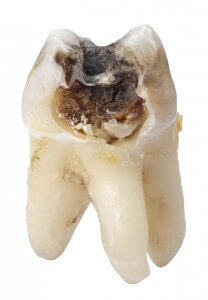
If a tooth has decayed beyond the point of natural healing, it will require a filling to stop the infection spreading any further.
The treatment process will depend on how far inside the tooth the decay has spread. Your dentist may need to take an x-ray to assess the size and extent of the cavity, especially if you have a cavity between teeth that is hard to see.
If you catch the problem in the early stages, before the enamel layer has been fully eroded, your dentist may be able to remove the decay and apply a small filling without you needing an anaesthetic injection. This is because there are no nerves in tooth enamel.
In cases where the infection has spread further, your dentist will administer an anaesthetic to prevent pain during your tooth cavity filling. For a small cavity, treatment is usually straightforward and takes less than 10 minutes.
If dental decay has spread into the pulp chamber and tooth root, you will need root canal treatment to remove all of the decayed material. Your dentist may recommend you get a crown on your tooth to strengthen it and protect against further damage.
Where decay is widespread and there is very little healthy tooth left, your dentist will remove the decayed tooth completely. You can avoid this by visiting your dentist as soon as you experience any tooth decay symptoms, though.
If you need to have a tooth extracted, your dentist will explain the options for replacing it with an artificial tooth. These include dentures, bridges and tooth implants.
Using Silver Diamine Fluoride (SDF) to stop decay
Silver Diamine Fluoride (SDF) is a newly developed technology and treatment in dentistry used to prevent teeth cavities or caries from forming, growing, or spreading to other teeth. SDF is a safe, painless alternative to traditional cavity drilling procedures.
What are the ingredients in SDF?
You may be wondering what exactly is in Silver Diamine Fluoride, so we have listed the ingredients below:
- Silver: Kills bacteria
- Water: Provides a liquid base for the solution
- Fluoride: Helps your teeth rebuild (enamel repair through remineralisation)
- Ammonia: Keeps the solution concentrated so that it’s as effective as possible against cavity resonance
Advantages and Disadvantages of SFD treatment
Research suggests that there is no reason for dentists to do any other type of restoration work on a patient’s teeth before treating them with SDF. It also suggests that an application of 38% SDF is needed to show a good result in enhancing dental caries management in children and adolescents. This includes the treatment of those with special health care needs.
SDF is considered effective, safe and harmless and is widely used nowadays by dentists for adolescents and children. While it has many advantages it also has some side effects. The following table will compare the advantages and disadvantages of SDF treatments:
Advantages | Disadvantages |
Effective in stopping cavity development after it has formed | Can't be used for patients with a silver allergy |
Kills the bacteria that breaks down tooth enamel | Can't be used for patients with oral ulcerations or canker sores |
Alternative to drilling cavities | Can't be used for patients with extensive caries or gum diseases |
Use for Dentin desensitization, caries arrest, and caries prevention | Can leave black stains around the treatment area |
Advanced research shows that SDF can be used with potassium iodide or nano-silver fluoride (NSF) which limits SDF’s black staining.
NHS treatment for a tooth cavity
The good news is that all of the treatments mentioned above, except dental implants and SDF, are covered by the NHS. If you’re under 18, pregnant, have had a baby in the last 12 months, or are receiving certain benefits, you’re entitled to free NHS treatment. Otherwise, the following charges will apply:
Treatment | Purpose | Cost with NHS |
Checkup | Identify problems and give oral health advice | £23.80 |
Apply fluoride varnish | Protect against decay | £23.80 |
Tooth filling | Remove decay and repair tooth | £65.20 |
Root canal | Remove decay deep inside tooth | £65.20 |
Extraction | Remove badly decayed tooth | £65.20 |
Crown | Protect tooth after damage or treatment | £282.80 |
Bridge | Replace a missing tooth | £282.80 |
Prices correct as of May 2021. Only one charge is applied per course of treatment. If you need more than one treatment, the highest rate will apply. | ||
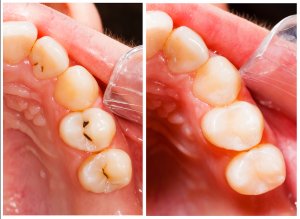
Do note that NHS fillings typically use a metal alloy unless they are in a prominent position (e.g. front teeth). If you prefer not to have a silver cavity filling on your back teeth you will need to pay for private treatment. A filling with white composite material costs from £40 for a small cavity. Larger fillings may cost £100 or more.
If you are unable to enlist as an NHS patient for some reason, you will need to be treated as a private patient.
Insurance for dental treatment
If you have dental insurance, you may well be covered for fillings, root canal work, extractions, and other procedures to treat tooth decay. If your dental work isn’t urgent, you might be able to take out a new insurance policy, but do be aware that waiting periods, annual limits and exclusions usually apply.
Even if a new policy won’t cover you for the work you need now, it might help lower your next dental bill.
Tooth decay in children
Sadly, about 530 million children suffer from dental caries of their milk teeth, which can lead to teeth cavities. In poorer countries decayed teeth are common due to the lack of available health care. In the UK around a quarter of five-year-olds have dental caries, and thousands of children have to have teeth removed in hospital each year.
Ways that parents can help prevent toddler and child tooth decay include:
- Be aware of how much sugar is in their food – not just sweet foods but things like pasta sauces and fruit juices
- Limit snacking between meals to foods that aren’t high in sugar or carbohydrates (raw vegetables and fruits are ideal)
- Supervise tooth brushing until your child is seven or older
- Use a suitable children’s toothpaste that contains fluoride
- Take them for regular dental checkups so any problems can be treated early
The Change4Life website has some useful tips for reducing your child’s sugar intake and offering a healthier lifestyle. This will not only lower their chances of dental decay and cavity pain; their health will benefit in many ways.
Children often hear things like, ‘don’t eat too much candy or you’ll get a cavity,” but it is not only children at risk of cavities and tooth decay. Plus, it’s not necessarily the candy that causes cavities, rather, it’s the environment sugar creates in your mouth that is the problem. This can affect children and adults alike. Recently, it has even been shown that adults over 65 are experiencing tooth decay at a higher rate than school children. If you’re concerned about tooth decay be sure you’re:
- Brushing your teeth twice a day, two minutes each time
- Flossing each evening
- Incorporating fluoride in your routine
- Seeing your dentist every six months
Dr. Catalina Botero, Li’l Sunshine Smiles Dentistry
Treating children’s teeth
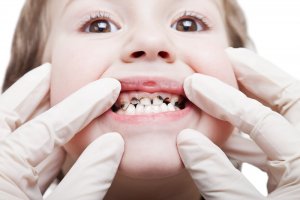
It can be distressing to realise your child has a tooth cavity, but the sooner you visit the dentist the greater your chances of being able to reverse the damage. Baby teeth are particularly good at remineralising themselves, so your toddler or child may not require a filling.
Your dentist will advise you on how to stop decay in your child’s teeth. They may apply a fissure sealant, covering the grooves in the back teeth which are particularly at risk of decay.
The NHS also recommends applying a fluoride varnish at least twice a year for children aged three and over. Younger children may receive this treatment if the dentist thinks it is necessary. This varnish protects teeth from bacteria and remineralises enamel in the early stages of decay.
If your child does need a filling, it’s quite possible they won’t need an injection. If they do, the dentist will apply a numbing gel to the gum so they don’t feel any pain from the needle.
Even if you feel nervous about your child or toddler getting a tooth filling, try to stay calm and positive. If not your little one can pick up on your feelings and may think that visiting the dentist is a bad thing. This might deter them from seeking the dental care they need later in life.
Conclusion
This is a problem that few of us will successfully avoid completely. Dental caries can be treated simply and even reversed if you seek treatment early on. The longer you put off visiting a dentist after you notice caries and cavity symptoms, the more extensive (and costly) your treatment is likely to be.
Follow the tips in this article for improving your oral health and managing your food and drink intake. This should at least reduce your chances of getting a dental cavity if not prevent decay completely.
FAQs
Can tooth decay be reversed?
The enamel in our teeth can remineralise itself to a certain degree and you can improve your oral health to help stop and reverse tooth decay. Your dentist can also provide treatments to stop decay.
Is there a cure for tooth decay?
The cure for tooth decay is preventing it altogether. You can do this by making changes to your lifestyle including reducing sugary foods and drinks to improve your dental health. There are treatments available to help stop and reverse tooth decay, such as fluoride gel, antiseptic varnish, fissure sealants and Silver Diamine Fluoride (SDF).
If your teeth have progressed passed the early stages, and you have a cavity you may need dental work. You could need a filling, or a root canal, and your dentist may suggest a crown to strength the tooth. And, if you need to get a tooth extracted you may need a denture or implant to replace the missing tooth.
Does tooth decay smell?
Yes, tooth decay can cause you to have bad breath (halitosis). This is because tooth decay is a build-up of plaque and bacteria and eventually tooth rot, all of which have an unpleasant smell.
Can oil pulling help tooth decay?
Research has found that oil pulling significantly reduces the number of bacteria in your mouth, preventing tooth decay. However, once you have a cavity oil pulling will not be able to reverse it. A cavity is irreversible because the enamel layer is permanently damaged. If you have a cavity you will need to seek treatment from a dental professional.
What are the first signs of tooth decay?
The first sign of tooth decay is generally a small white or brown spot on your tooth. Other signs include toothache, tooth sensitivity, bad breath or a nasty taste in your mouth.
Oral Health Foundation: How your favourite tipple could be changing the bacteria in your mouth… and it’s not good news. Consulted July 2018.
World Health Organisation: Oral Health. Consulted 4th January 2022.
NHS. Healthier Families. Consulted 4th January 2022.




